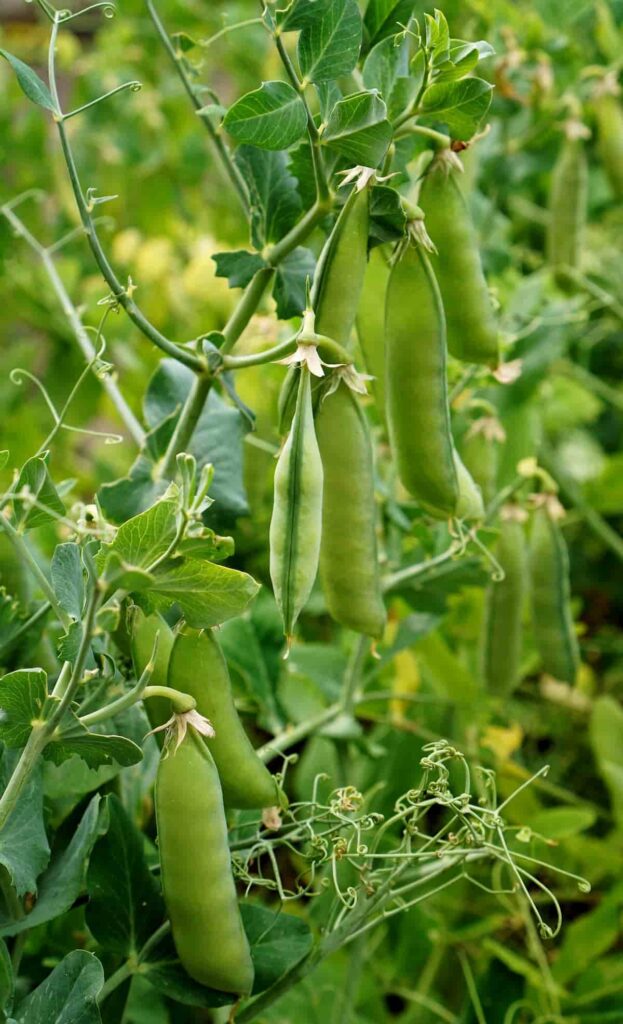Peas are one of the popular vegetables to grow in the USA. Peas are an incredibly versatile vegetable. Peas are also a great source of vitamins and minerals, making them a healthy addition to any diet. Peas are annual pulse legume crops consumed throughout the globe and grown in cold climates. North America is the world’s largest producer and exporter of dried Peas. If you’re interested in growing Peas in the USA, you need to know a few essential things about the plant and the best practices for soil, propagation, planting, care, and harvesting.
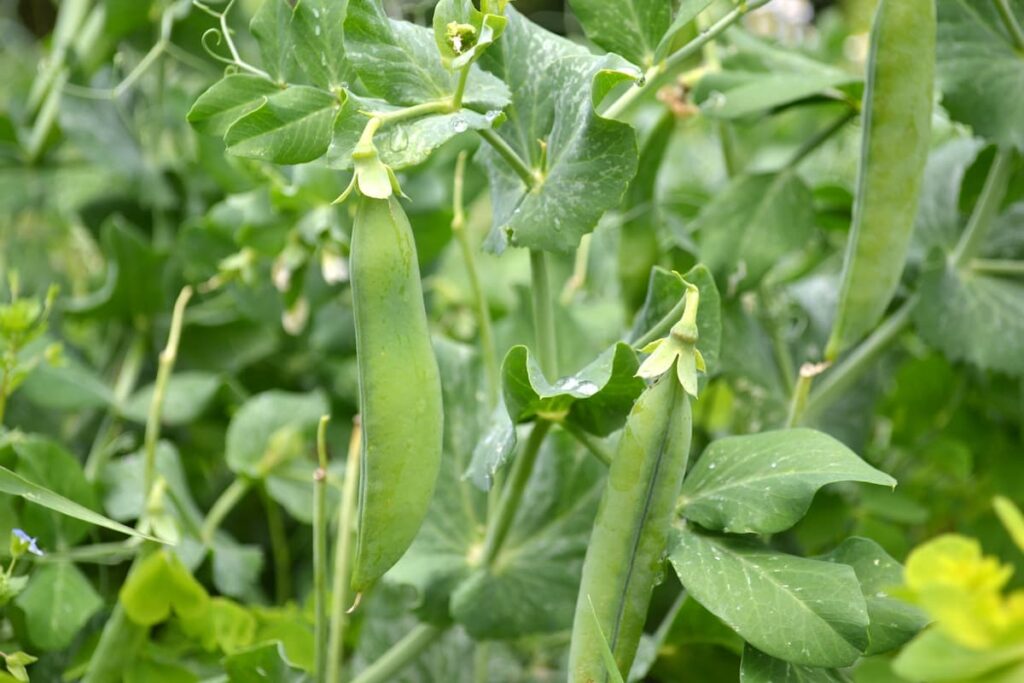
How to grow peas in the USA
Soil requirement for growing Peas in the USA
- The ideal soil for growing Peas in the United States is a deep, well-drained loam with a pH of 6.0 to 7.0. Peas do not do well in soils that are waterlogged or overly sandy.
- To prepare the soil for Pea’s planting, loosen it to a depth of 12 inches and then mix in about 2 to 4 inches of organic matter like aged manure or compost. Consider amending your soil with sand to improve drainage if it is heavy clay.
- Peas should be planted in early spring. To ensure good drainage, plant Peas on raised beds or hillsides
- it is essential to choose the right soil for your Peas. Peas need well-drained, fertile soil that is high in organic matter.
- Preparing the soil is key to growing healthy Peas. The soil must be loose and well-drained so the roots can quickly spread. Add some organic matter to the soil, such as compost or manure, to help improve its structure. You can also add a Pea fertilizer to the soil before planting. Once the soil is prepared, it’s time to plant your Peas.
Peas growing areas in the USA
- Peas were mainly grown in the Idaho and Palouse region of Washington. The top green Pea-producing states following Minnesota are Washington, Wisconsin, Oregon, and New York.
- In the United States, Peas are grown in all states except for Alaska. The main Pea-producing states are Idaho, Oregon, and Washington. They should be planted in full sun and well-drained soil.
- In terms of specific locations, many gardeners in the northern US have success growing Peas. Suitable areas for Pea production include Washington, Oregon, Idaho, Montana, Wyoming, North Dakota, and Minnesota. Canadian provinces such as British Columbia and Alberta are good places to grow Peas.
- Many different Peas can be grown in the USA and have a wide range of ideal growing conditions. However, there are a few general things to remember when growing Peas in the USA.
- Firstly, it is essential to choose a Pea variety that is well-suited to the climate in your area. Peas need cool weather to thrive, so they are typically best suited to areas with cooler summers and mild winters.
In case you missed it: How to Grow Spinach in USA: Soil, Propagation, Planting, Care, and Farming Tips
Pea growing conditions in the USA
- Producing a good crop of Peas in the United States requires paying attention to soil and weather conditions. Peas are a cool-season crop that can withstand frost and grow best in spring or fall. Peas should be planted in most parts of the country as the ground can be worked in the spring.
- The ideal soil temperature for Pea planting is between 4-15°C. If the soil is too cold, the seeds will not germinate; if it is too hot, they may germinate poorly or unevenly. Peas do not like wet feet, so make sure your field has good drainage.
- In terms of weather, Peas prefer moderate temperatures and plenty of moisture. Temperature levels that are too hot or too cold can cause problems with pollination and result in poorer yields. Drought stress can also lead to smaller, tougher Peas. Too much rain can cause problems with mold and mildew.
How to propagate Peas in the USA?
To grow Peas in the United States, you will need to start with soil rich in organic matter. Peas are a cool-season crop so they can be planted as early as two weeks before the last frost date in your area. To propagate Peas, you can directly sow them into the ground, start them indoors, and then transplant them outside. Once they are transplanted, water them well and keep the soil moist. When the plants begin to flower, you will need to support them with a trellis or other structure so that they can continue to grow vertically.
Growing Peas in pots
- Peas growing in pots is a great method to get more yield. Peas also have a short growing season so you can have fresh Peas in as little as two months.
- To grow Peas in pots, start with a good quality potting mix and sow the seeds about 1 inch deep. Once the seedlings emerge, thin them to 4-6 inches apart. Peas need full sun and moderate moisture to grow well. Water your plants regularly, and fertilize them every few weeks with a balanced fertilizer
- Harvest your Peas when the pods are plump before they start to yellow.
In case you missed it: How to Grow Okra in USA: Soil, Propagation, Planting, Care, and Farming Tips
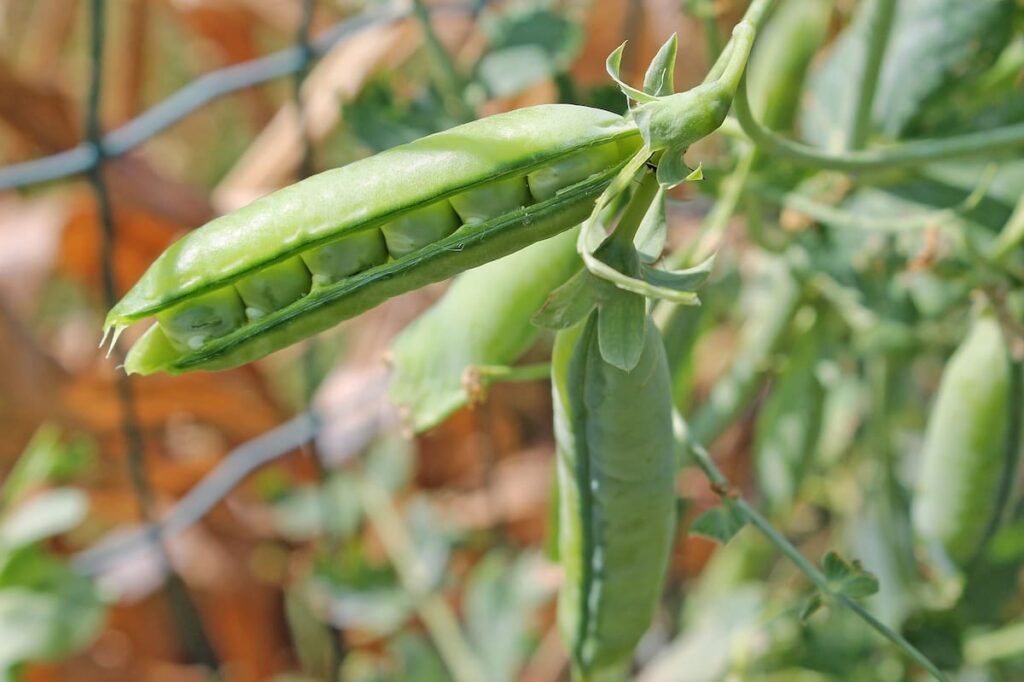
Tips for growing Peas from seeds in the USA
Pea seeds must be sown directly into the ground as soon as the soil can be worked in late winter or early spring. To give your Peas a head start, you can sow them indoors 4-6 weeks before your last frost date.
When choosing a Pea variety, there are two main types: English Peas and snow Peas. English Peas are the more traditional type that is often found canned or frozen. They have large, plump seeds and require shelling before eating. Snow Peas have smaller, flatter seeds and can be eaten straight off the vine – no shelling required.
Once you’ve selected your variety, it’s time to get started on propagation. To do this, fill a seed tray or pot with moistened seed-starting mix. Sow your seeds about 1 inch apart and ½ inch deep. Cover with plastic wrap or a lid to create a humid environment for germination. Place your tray or pot in a warm location out of direct sunlight.
Growing Peas at home in the USA
- You can easily grow Peas at home if you live in the USA. All you need is some soil, a bit of water, and some patience. Peas prefer cooler weather and will not do well if it gets too hot.
- To get started, you will want to gather some supplies. First, get some Pea seeds from your local garden store or online. You will also need some soil and a container to plant them in if you are using a pot with drainage holes in the bottom.
- Once you have your gardening supplies, it’s time to get started. Fill your pot with soil and wet it with a spray bottle or watering can. Next, plant your Pea seeds an inch apart and cover them with more soil. Gently pat down the soil and then water again.
- Place your pot in a sunny spot and keep an eye on the soil. You will need to water it regularly, but don’t overdo it, as Peas prefer moist but not soggy conditions. After about 6-8 weeks, your Peas should be ready to harvest.
Green Peas growing season in the USA
- The best time to plant green Peas in the USA is spring. The average last frost date in the US is around April 15th, but this can vary depending on your location.
- You can start planting Peas as early as late February or early March in some parts of the country. However, Pea plants are very susceptible to frost damage, so waiting until the risk of frost has passed is essential before planting them outdoors.
- Once your Peas are planted, they will need about 60 days to mature. Peas are a cool-weather crop, so they will do best if planted in early spring or late fall. You can also plant Peas in late winter for a spring harvest in warmer climates.
- Green Peas are a great source of vitamins and minerals and are relatively easy to grow. With a little planning and care, you can enjoy fresh green Peas from your garden all season long.
In case you missed it: How to Grow Eggplant in USA: Soil, Propagation, Planting, Care, and Farming Tips
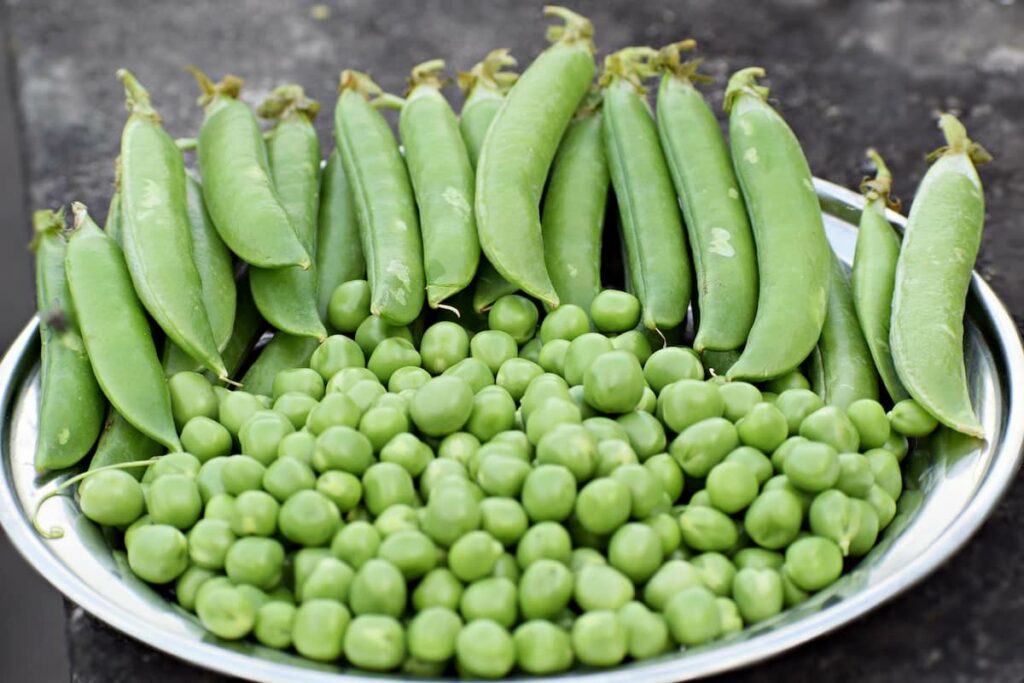
How to support Peas when growing?
- To grow Peas in the United States, you must start with suitable soil. Peas prefer well-drained soil that is high in organic matter. To improve the soil quality, add compost or manure to your garden bed before planting.
- Once you have suitable soil, you must propagate your Peas. This can be done by seed or by cutting. If you are growing by seed, you will need to sow the seeds about 1-2 inches deep in the soil. If you are growing by cuttings, you will need to take 4-6 inch cuttings from an existing plant and root them in moist sand or vermiculite.
- After your Peas have been propagated, it is time to plant them. Peas should be planted about 2-3 inches apart in rows 18-24 inches. Once they are planted, water them well and keep the soil moist but not soggy.
- As your Peas grow, they will need support. You can provide support by putting up a trellis or using chicken wire along the perimeter of your garden bed. The Peas will climb these structures as they grow and produce more fruit.
- Caring for your Pea plants is relatively simple. Water them regularly and fertilize them every few weeks with a nitrogen-rich fertilizer.
Peas varieties in the USA
There are numerous varieties of Peas that can be grown in the USA. Each variety has its unique flavor, texture, and color.
The most popular varieties of Peas in the USA are:
- Snow Peas: These are a type of Pea harvested while the pods are still young and tender. They have a sweet flavor and crisp texture.
- English Peas: English Peas are a type of Peas typically larger than other varieties. They have a nutty flavor and chewy texture.
- Sugar Snap Peas: These are harvested when the pods are slightly mature. They have a sweet flavor and crunchy texture.
- Blackeye Peas: Blackeye Peas are a type of Peas that is typically used in soups and stews. They have an earthy flavor and creamy texture.
In case you missed it: USA Soil pH Chart: Ideal and Optimum Range for Vegetables, Fruits, Flowers, and Herbs
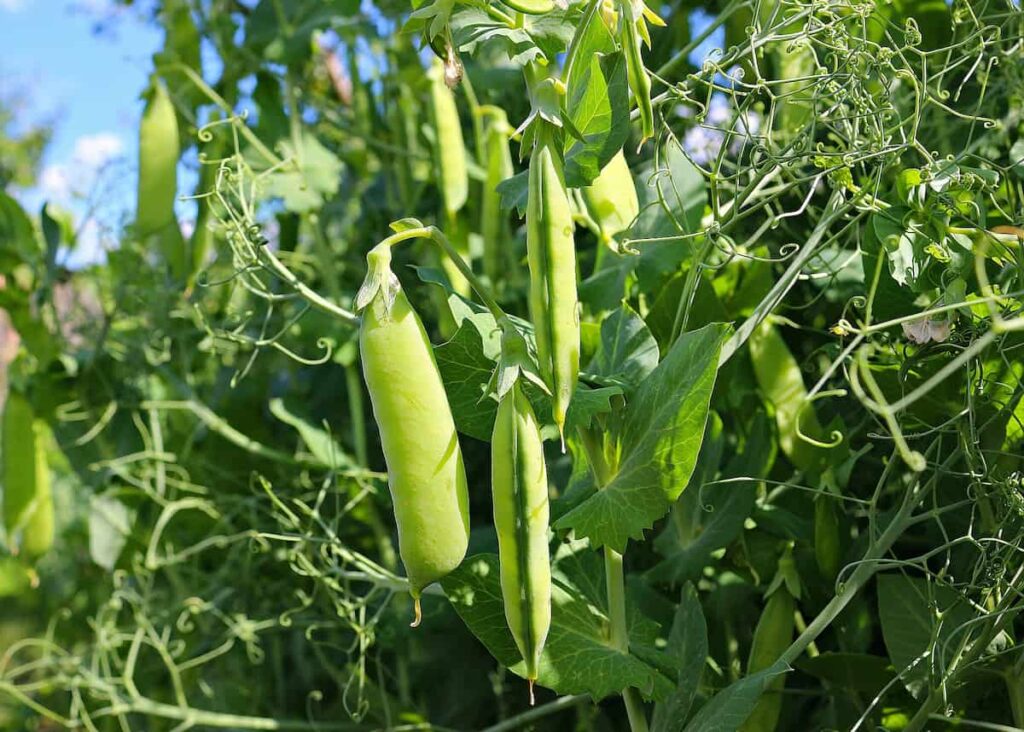
Fertilizer requirements for growing Peas in the USA
Soil test results will guide fertilizer recommendations. In general, Peas do not require high levels of nitrogen fertilization. Excessive nitrogen will promote vegetative growth at the expense of Pea pod production. For best results, apply a starter fertilizer at planting time and side dress with additional nitrogen when the plants are about 6 to 8 inches tall and beginning to bloom.
Water requirement for growing Peas
- Water is essential for Pea plants, as they are 85% water. The amount of water that Peas need depends on the stage of their growth. For example, Pea plants need more water when flowering and producing pods.
- It is best to provide Peas with a deep watering once a week rather than frequent shallow watering. This encourages deep root growth, which helps the plant withstand drought conditions.
- If you live in the USA with high-temperature levels and low rainfall, you may need to water your Pea plants more often. During periods of extended dry weather, it is essential to monitor the soil moisture level and water accordingly. Peas can tolerate some drought conditions, but if the soil becomes too dry, the plants will stop growing and producing pods.
Pea growing problems in the USA
- Several problems can occur when growing Peas in the USA. The soil may not be rich enough in nutrients, the plants may not get enough water, or there may be pests or diseases.
- If the soil is not nutrient-rich, the plants will not grow well and will yield a poor crop. Peas need a lot of nitrogen to grow well, so adding organic matter, such as compost or manure, to the soil before planting can help.
- If the Peas plants are not getting enough water, they will wilt and eventually die. Make sure to water the plants regularly, especially during hot weather. Pests and diseases can also be a problem for Pea plants.
- Insects: Pea aphids are the most common insect pest of Peas. They suck the sap from the plants and can cause the leaves to curl and the plants to become stunted. Aphids can also transmit viruses to plants. Other insect pests include thrips, leafhoppers, and cutworms.
- Diseases: The most common disease of Peas is powdery mildew. This fungus attacks the leaves and causes them to turn white or grayish-white. It can also cause the stems to become brittle and break easily. Other diseases include root rot, fusarium wilt, and mosaic virus.
- Poor Cultural Practices: Poorly drained soils or soils that stay too wet can lead to problems with Pea plants. Waterlogged soils prevent oxygen from reaching the roots, which can cause them to rot. Soils that are too dry can also cause problems, as Peas need consistent moisture during their growing season.
- There are several methods to control pests and diseases in Peas. One method is to use an insecticide or fungicide. Another method is to grow resistant varieties of Peas. Yet another method is to practice crop rotation. This involves growing a different crop in the same location each year. This helps to break the life cycle of plant pests and diseases and prevents them from becoming established in the soil.
- To control aphids, bean beetles, caterpillars, leafhoppers, and stink bugs, you can use an insecticide or spray your plants with water regularly. To control powdery mildew, downy mildew, fusarium wilt, and root rot, you can grow resistant Peas or treat your plants with a fungicide.
- Yields for Peas in the USA vary greatly depending on the region and growing conditions. In general, Peas do quite well in the US, with yields often exceeding those seen in other parts of the world.
In case you missed it: Seed Sowing and Harvesting Chart for Vegetables in the USA
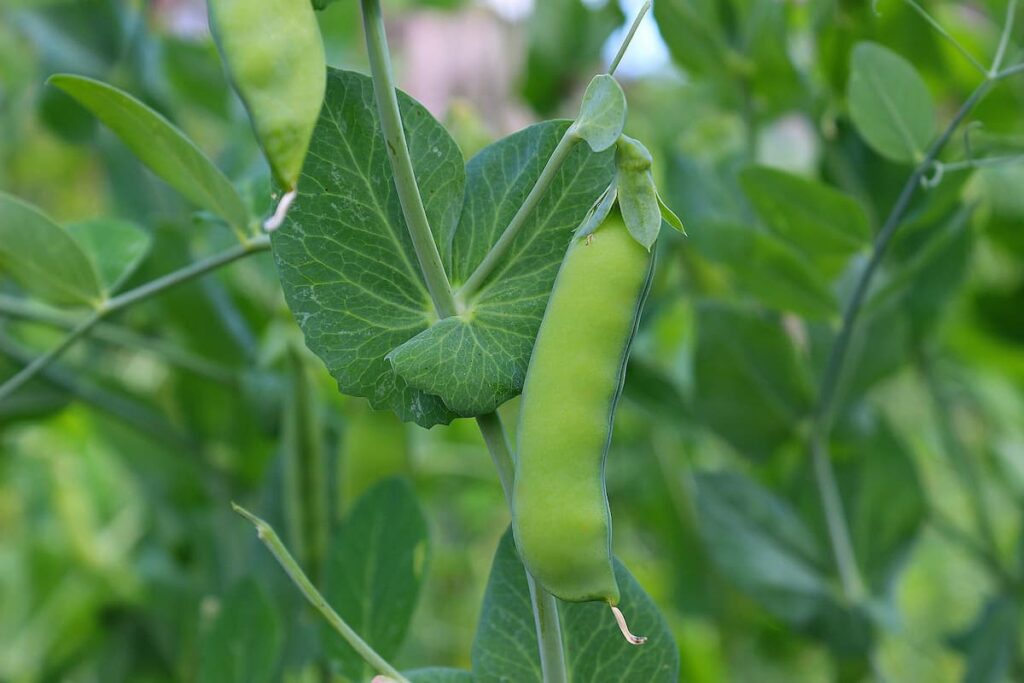
Peas harvesting tips
Assuming you would like tips on harvesting Peas:
- Peas are typically ready to harvest 60-70 days after planting.
- To check if your Peas are ready, pop one open and see if it is tender and sweet. If it is, then your Peas are ready to be harvested.
- When harvesting Peas, use a sharp knife or shears to avoid damaging the plant.
- Cut the plant stem an inch above the Pea pod and leave some plant leaves so it can continue to photosynthesize and produce more Peas.
Conclusion
Peas are a cool season crop. To grow Peas in the USA, you must start with well-drained, loose soil high in organic matter. Peas do not like to have their roots disturbed, so it is best to sow them directly into the ground or into biodegradable pots that can be planted directly into the ground.
- Economical Aquaculture: A Guide to Low-Budget Fish Farming
- 15 Common Planting Errors That Can Doom Your Fruit Trees
- How to Make Houseplants Bushy: Effective Tips and Ideas
- Innovative Strategies for Boosting Coconut Pollination and Yield
- Pollination Strategies for Maximum Pumpkin Yield
- The Complete Guide to Chicken Fattening: Strategies for Maximum Growth
- Natural Solutions for Tulip Problems: 100% Effective Remedies for Leaf and Bulb-Related Issues
- Revolutionizing Citrus Preservation: Towards a Healthier, Greener Future
- Natural Solutions for Peony Leaf and Flower Problems: 100% Effective Remedies
- Maximizing Profits with Avocado Contract Farming in India: A Comprehensive Guide
- Natural Solutions for Hydrangea Problems: 100% Effective Remedies for Leaf and Flowers
- The Ultimate Guide to Choosing the Perfect Foliage Friend: Bringing Life Indoors
- From Sunlight to Sustainability: 15 Ways to Use Solar Technology in Agriculture
- The Ultimate Guide to Dong Tao Chicken: Exploring from History to Raising
- The Eco-Friendly Makeover: How to Convert Your Unused Swimming Pool into a Fish Pond
- Mastering the Art of Delaware Chicken Farming: Essentials for Healthy Backyard Flocks
- 20 Best Homemade Fertilizers for Money Plant: DIY Recipes and Application Methods
- How to Craft a Comprehensive Free-Range Chicken Farming Business Plan
- Brighten Your Flock: Raising Easter Egger Chickens for Beauty and Bounty
- How to Optimize Your Poultry Egg Farm Business Plan with These Strategies
- Subsidy for Spirulina Cultivation: How Indian Government Schemes Encouraging Spirulina Farmers
- Ultimate Guide to Raising Dominique Chickens: Breeding, Feeding, Egg-Production, and Care
- Mastering the Art of Raising Jersey Giant Chickens: Care, Feeding, and More
- Ultimate Guide to Raising Legbar Chickens: Breeding, Farming Practices, Diet, Egg-Production
- How to Raise Welsummer Chickens: A Comprehensive Guide for Beginners
- How to Protect Indoor Plants in Winter: A Comprehensive Guide
- Ultimate Guide to Grow Bag Gardening: Tips, Tricks, and Planting Ideas for Urban Gardeners
- Guide to Lotus Cultivation: How to Propagate, Plant, Grow, Care, Cost, and Profit
- Agriculture Drone Subsidy Scheme: Government Kisan Subsidy, License, and How to Apply Online
- Ultimate Guide to Raising Araucana Chickens: Breed Profile, Farming Economics, Diet, and Care
- Bringing Hydroponics to Classroom: Importance, Benefits of Learning for School Students
- Ultimate Guide to Raising Polish Chickens: Breed Profile, Farming Economics, Diet, and Care
- Ultimate Guide to Raising Australorp Chickens: Profile, Farming Economics, Egg Production, Diet, and Care
- Silkie Chicken Farming: Raising Practices, Varieties, Egg Production, Diet, and Care
- Sussex Chicken Farming: Raising Practices, Varieties, Egg Production, Diet and Care
- Homemade Feed Formulations for Livestock: Discover Cost-effective Starter to Finisher Feed Recipes
